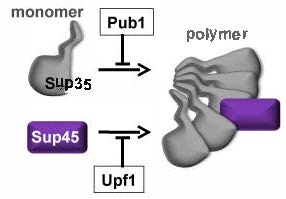The [PSI+] nonsense-suppressor determinant of Saccharomyces cerevisiae is related to formation of heritable amyloids of the Sup35 (eRF3) translation termination factor. [PSI+] amyloids have variants in amyloid structure and in the strength of suppressor phenotype. Appearance of [PSI+], its propagation and manifestation depend primarily on chaperones. Besides chaperones, the Upf1/2/3, Siw14 and Arg82 proteins restrict [PSI+] formation, while Sla2 can prevent the [PSI+] toxicity. Here, we identify two more non-chaperone proteins involved in [PSI+] detoxification. We show that simultaneous lack of the Pub1 and Upf1 proteins causes lethality of [PSI+] cells with a strong, but not with weak suppressor phenotype. This lethality results from excessive depletion of the Sup45 (eRF1) termination factor due to its sequestration into Sup35 polymers. We also show that Pub1 acts to restrict excessive Sup35 prion polymerization, while Upf1 interferes with Sup45 binding to Sup35 polymers. These data allow considering the Pub1 and Upf1 proteins as a novel [PSI+] detoxification system.

